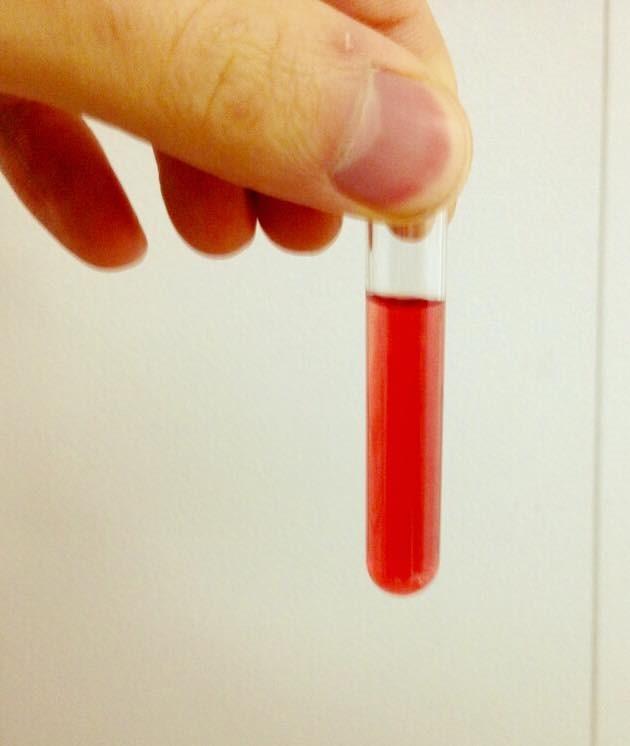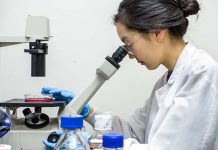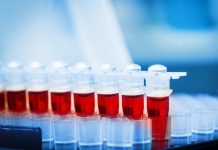Most biological processes are carried out by complexes of multiple proteins that work together to carry out some function. How these complicated structures could have evolved is one of modern biology’s great puzzles, because they generally stick together using elaborate molecular interfaces, and the intermediate forms through which they came into being have been lost without a trace.
Now an international team of researchers led by University of Chicago Professor Joseph Thornton, PhD, and graduate student Arvind Pillai has revealed that complexity can evolve through surprisingly simple mechanisms. The group identified the evolutionary “missing link” through which hemoglobin — the essential four-part protein complex that transports oxygen in the blood of virtually all vertebrate animals — evolved from simple precursors. And they found that it took just two mutations more than 400 million years ago to trigger the emergence of modern hemoglobin’s structure and function.
The study, “Origin of complexity in haemoglobin evolution,” will be published online in the journal Nature on May 20. The team also includes scientists at Texas A&M University, University of Nebraska-Lincoln, and Oxford University (UK).
Each hemoglobin molecule is a four-part protein complex made up of two copies each of two different proteins, but the proteins to which they are most closely related do not form complexes at all. The team’s strategy, pioneered in Thornton’s lab over the last two decades, was a kind of molecular time travel: use statistical and biochemical methods to reconstruct and experimentally characterize ancient proteins before, during and after the evolution of the earliest forms of hemoglobin. This allowed them to identify the missing link during hemoglobin evolution – a two-part complex, consisting of two copies of a single protein, which existed before the last common ancestor of humans and sharks. This ancient two-part complex did not yet possess any of modern hemoglobin’s critical properties that allow it to bind oxygen in the lungs and deliver it to distant cells in the brain, muscles and other tissues.
By introducing into this missing link protein various mutations that occurred during the next historical interval, they found that just two mutations on the protein’s surface triggered formation of the four-part complex and imparted the critical changes in its oxygen-binding function.
The traditional view of the evolution of biological complexity — first proposed by Charles Darwin and elaborated recently by Richard Dawkins — is that complexity increases gradually through a long journey of many mutations, each of which is favored by natural selection because it causes small improvements in function and fitness. The new research shows that, at the molecular level at least, new complex forms can be brought into being very quickly.
“We were blown away when we saw that such a simple mechanism could confer such complex properties,” Thornton said. “This suggests that jumps in complexity can happen suddenly and even by chance during evolution, producing new molecular entities that eventually become essential to our biology.”
The project began when Pillai, a graduate student in the Department of Ecology and Evolution, approached Thornton and Georg Hochberg, PhD, a postdoctoral scholar in his laboratory, with the idea that hemoglobin could be a test case to see how complex molecules evolved throughout history.
“Hemoglobin’s structure and function has been studied more than perhaps any other molecule,” said Pillai. “But nothing was known about how it originated during evolution. It’s a great model because hemoglobin’s components are part of a larger protein family in which the closest relatives don’t form complexes but function in isolation. Their history can be reconstructed from the sequences of its modern descendants, and there are great laboratory tools for characterizing their properties.”
Thornton said that Pillai’s idea was “brilliant, and it inspired a massive amount of experimental work by Arvind and the rest of the team.” Speculation about how hemoglobin might have evolved goes back at least 60 years to Linus Pauling and Max Perutz, the founding fathers of protein biochemistry, but until now there was no way to study the problem experimentally.
Analysis of the ancient proteins’ atomic structures showed how the two mutations took advantage of even more ancient features to assemble the intermediate two-part complex into the four-part complex. The mutations introduced two changes on the protein surface that allowed it to bind tightly to the surface of the other protein, which remained unchanged as it was recruited into the new interaction. Other ancient parts of the two surfaces also stuck together simply by chance, adding further strength to the interaction that was triggered by the two new mutations. Those older elements, Thornton pointed out, and even the two-part complex itself, must have existed then by chance, rather than because they enhanced the protein’s final structure or function, because they evolved before those properties came into being.
Perhaps the most surprising result was that the two critical mutations, by inducing formation of the four-part structure, also triggered the critical changes in the complex’s oxygen-binding functions. Hemoglobin can perform its physiological function because its affinity for oxygen is high enough to bind oxygen in the lungs, but low enough to release it in the tissues elsewhere in the body. It also binds oxygen cooperatively: When one of the four components takes up a molecule of oxygen, the other components tend to do the same – and this happens in the reverse direction, as well — so the whole complex becomes even more effective at recruiting oxygen and releasing it in the right places.
Hemoglobin’s ancient precursors – including the missing link two-part complex – bound oxygen too tightly and were not cooperative, so they could not have effectively performed the oxygen-exchange function. The researchers found that the two key mutations not only conferred the four-part structure but also imparted hemoglobin’s critical oxygen-binding properties. Although the mutations are on the part of the protein’s surface that assemble the complex together – not at its oxygen-binding site – the two regions are connected by an ancient string of amino acids found in all members of the globin protein family. When the four-part complex assembles, this string moves, and the oxygen-binding site is reshaped in a way that makes it bind oxygen more loosely. And when one component of the hemoglobin complex does bind oxygen, the string moves back, reshaping the surface that binds the neighboring proteins together, which allows the neighbor to get better at binding oxygen, too. In this way, complex functional properties appeared as an immediate side effect when hemoglobin’s ability to assemble first evolved.
“Imagine if those two mutations never occurred, or if the structural features that they took advantage of weren’t in place at the time,” Thornton said. “Hemoglobin as we know it would not have evolved, and neither would many of the subsequent innovations that depend on efficient oxygen transport, like rapid metabolism and the ability to grow much larger and move much faster than our ancient marine ancestors.”




